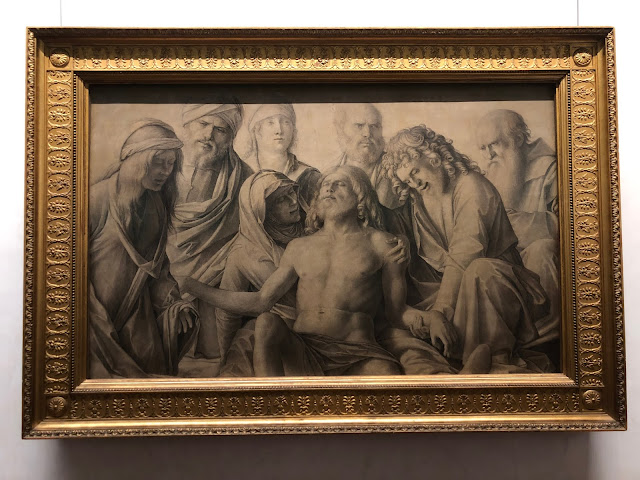【フィレンツェ】ウフィツィ美術館 マンテーニャ、ベッリーニ Firenze - Gallarie degli Uffizi : Andrea Mantegna & Giovanni Bellini
続いての小部屋には、マンテーニャとヴェネツィア派の作品が展示されていた。
アンドレア・マンテーニャは、1431年にパドヴァ近郊に生まれた。
大学の町として知られるパドヴァで画家として活躍を初めて、やがて、マントヴァ公のルドヴィーコ・コンザーガに招かれて、マントヴァの宮廷で活躍した。
徹底して遠近法を駆使した作品を制作したことで知られている。これはデッサンだが、十分に見応えのある、素晴らしい作品だ。
In the next small room, Mantegna and Venetian works were exhibited.
Andrea Mantegna was born in 1431 near Padua.
He was the first painter in Padua, known as the university town, and was eventually invited by the Duchy of Mantova, Ludovico Consaga, to play in the court of Mantova.
He is known for producing his work in full perspective. This is a drawing, but it's a great work that is well worth seeing.
マンテーニャは、ヴェネツィアの画家、ヤーコポ・ベッリーニの娘と結婚している。
ヴェネツィ派を代表するジョバンニ・ベッリーにとは義兄弟にあたる。
ベッリーニは、義理の兄だったマンテーニャの画風から大きな影響を受けた。
同じ部屋に展示されていた『聖なる寓意』というベッリーニの作品には、画面の手前のテラスの描き方に、マンテーニャから学んだ遠近法がよく活かされている。
この絵の中には、手前のテラスだけでなく、湖の向こう側にまで、多くの人が描かれていて、それぞれが何らかの寓意を示しているようだ。
Mantegna is married to the daughter of the Venetian painter Jacopo Bellini.
He is a brother-in-law to Giovanni Berry, who represents the Venetian school.
Berry was greatly influenced by the style of his brother-in-law, Mantegna.
Bellini's work, "Holy Allegory," exhibited in the same room, makes good use of the perspective learned from Mantegna in how to draw the terrace in front of the screen.
In this painting, many people are drawn not only on the terrace in the foreground but also on the other side of the lake, each of which seems to show some kind of allegory.
(Translated by Google Translate)




コメント
コメントを投稿